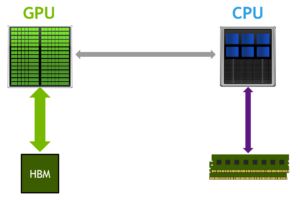Ram is called temporary memory because it stores data only temporarily. It loses data when the power is turned off.
Random Access Memory (RAM) is referred to as temporary memory because it is used by the computer to store data and machine code that is actively being used. Unlike permanent memory such as the hard drive, RAM is volatile, meaning it loses its contents when the computer is turned off.
This characteristic makes it suitable for rapid access and temporary storage of data that is currently being processed by the computer. Understanding the role of RAM as temporary memory is crucial in comprehending the overall functioning of a computer system.
The Origins Of The Term ‘temporary Memory’
The term ‘temporary memory’ refers to a crucial component within a computer’s architecture, commonly known as RAM. The origin of this term can be traced back to the early days of computing, when the concept of memory storage and processing was being developed.
From Random Access Memory To Ram
The term ‘random access memory’ initially referred to the primary memory storage in a computer, allowing for random access to data. Over time, this term evolved and was eventually shortened to ‘RAM.’ This change in terminology reflected the increased speed and efficiency of memory access and retrieval within computer systems.
The Evolution Of Terminology
As technology advanced, the terminology surrounding memory and storage underwent significant evolution. The term ‘temporary memory’ emerged as a simplified way to describe the dynamic nature of RAM, highlighting its function as a temporary storage space for data and instructions during computer operation.
How Ram Works
RAM is referred to as temporary memory because it stores data only when the computer is powered on. This volatile memory is responsible for real-time data access, allowing for faster processing and multitasking capabilities.
Understanding Ram’s Function
RAM (Random Access Memory) is a crucial component in any computer system. It plays a key role in the overall performance of the system by providing temporary storage for data and instructions that the CPU (Central Processing Unit) needs to access quickly. When the computer is turned off, the data stored in RAM is erased.
Exploring Ram Modules
RAM is made up of integrated circuits, and it comes in the form of small modules that are inserted into the motherboard of a computer. These modules are responsible for temporarily storing data that the CPU needs while it is performing tasks. Without sufficient RAM, the computer’s performance may suffer, and tasks may take longer to complete.
Differentiating Between Temporary And Permanent Memory
RAM, called temporary memory, stores data for immediate use by the computer. It is volatile, meaning it loses data when the power is turned off. This differentiates it from permanent memory, such as the hard drive, which retains data even when the power is off.
Comparing Ram And Rom
Now let’s dive into the comparison between Random Access Memory (RAM) and Read-Only Memory (ROM). These two types of memory play crucial roles in storing and retrieving data within a computer system. RAM, also known as temporary memory, is a type of computer memory that holds data that can be read from and written to by the computer’s processor. It is volatile and requires a constant supply of electricity to retain the stored information. Unlike ROM, RAM can store data on a temporary basis, enabling fast and efficient data access. On the other hand, ROM, which stands for Read-Only Memory, is non-volatile memory that contains data that is permanently stored and cannot be erased or modified by normal computer operations. It holds vital information required during the startup process of a computer, including the firmware and the computer’s basic input/output system (BIOS).The Role Of Temporary Memory In Data Processing
Temporary memory, or RAM, plays a crucial role in data processing. It provides a space for the computer to store and access data that is actively being used by the processor. When you open applications or perform tasks on your computer, the necessary data is loaded into RAM for quick retrieval. One of the key advantages of RAM is its faster read and write speeds compared to other types of memory. This speed allows the computer’s processor to quickly access the required data, resulting in enhanced performance and responsiveness. RAM acts as a temporary workspace for the processor to perform calculations, store intermediary results, and execute programs. Any data required by the processor is fetched from the RAM, processed, and then written back to the temporary memory as needed. As RAM is volatile, its contents are lost when the computer is turned off or restarted. However, this dynamic nature of RAM allows for flexibility and efficient memory management. The computer’s operating system and software determine how best to utilize the available RAM to optimize performance. It is important to note that the size and type of RAM installed in a computer have a significant impact on its overall performance. Computers with larger amounts of RAM can store and access more data simultaneously, resulting in smoother multitasking and faster program execution. In conclusion, temporary memory, or RAM, is an essential component of a computer system. It provides a fast and temporary storage space for the processor to retrieve and store data actively being used. This seamless data access and processing contribute to the overall speed and efficiency of a computer. On the other hand, ROM serves as permanent memory and contains vital information necessary for the computer’s initialization process. Understanding the difference between temporary and permanent memory helps in comprehending the intricate workings of a computer system.
Credit: fastercapital.com
Ram In Everyday Life
RAM in Everyday Life: RAM, or Random Access Memory, plays a crucial role in our everyday technological experiences. From computers to mobile devices, RAM ensures smooth and efficient performance. In this blog post, we will explore the importance of RAM in computers and the role it plays in mobile devices.
The Importance Of Ram In Computers:
In computers, RAM serves as the temporary workspace that allows the processor to access data quickly. Here are some key reasons why RAM is vital in computer systems:
- Fast Access to Data: RAM stores data that the processor needs to access frequently. By storing this data in RAM, computers can retrieve it quickly, resulting in faster processing speeds.
- Multi-tasking: RAM enables the computer to handle multiple tasks simultaneously. With sufficient RAM capacity, you can effortlessly switch between applications without experiencing any lag or slowdowns.
- Enhanced Performance: More RAM means the computer can store and access larger amounts of data. This leads to improved performance when running resource-intensive applications, such as video editing software or graphic design programs.
The Role Of Ram In Mobile Devices:
RAM is equally important in mobile devices, such as smartphones and tablets. Here’s why RAM plays a crucial role in their performance:
- App Loading and Switching: With adequate RAM, mobile devices can load apps quickly and switch between them seamlessly. This ensures a smooth user experience without frustrating delays or app crashes.
- Smooth Multitasking: RAM allows mobile devices to handle multiple apps simultaneously without compromising performance. You can effortlessly browse the web, stream music, and chat on social media without any noticeable slowdowns.
- Gaming Performance: For gamers, sufficient RAM is essential to run graphically demanding games smoothly. With ample RAM, you can enjoy immersive gaming experiences without experiencing lag or frame rate drops.
In conclusion, RAM serves as temporary memory in computers and mobile devices, providing fast access to data and optimizing overall performance. Whether you’re using a computer or a mobile device, ensuring sufficient RAM capacity is crucial for a seamless user experience.
Future Prospects And Advancements In Temporary Memory
Temporary memory, also known as RAM (Random Access Memory), plays a crucial role in the functioning of computers and electronic devices, serving as a temporary storage location for data that is actively being used by the system. It allows for quick access and retrieval of information, facilitating efficient multitasking and smooth operation. As technology continues to advance at an unprecedented pace, several emerging technologies are shaping the future of temporary memory. This article explores the exciting prospects and advancements in temporary memory technologies.
Emerging Technologies In Ram Development
In the quest for faster and more efficient memory solutions, researchers and developers are exploring various emerging technologies to enhance RAM capabilities. Some of the notable advancements include:
- Magnetoresistive RAM (MRAM): This technology utilizes the magnetic properties of materials to store data. Its non-volatile nature ensures data retention even when the power is turned off, overcoming one of the limitations of traditional RAM.
- Phase Change RAM (PRAM): PRAM exploits the reversible phase changes between amorphous and crystalline states of materials to store and retrieve data. It offers fast read and write speeds, low power consumption, and high endurance.
- 3D XPoint Memory: Developed by Intel and Micron, this revolutionary memory technology promises to bridge the gap between traditional RAM and solid-state drives (SSDs). It offers higher memory density, lower latency, and greater endurance compared to conventional RAM.
The Quest For Faster And More Efficient Memory Solutions
The ever-increasing demands for processing power and data storage have led to an ongoing quest to develop faster and more efficient memory solutions. As technology evolves, organizations are investing in research and development to push the boundaries of what is possible in temporary memory.
One of the key areas of focus is reducing latency, the time it takes for data to be accessed from memory. Lower latency translates into quicker response times and improved performance. Researchers are exploring advanced circuit designs, materials, and architectures to minimize latency and enhance the overall speed of temporary memory.
Efficiency is another crucial aspect being addressed by memory developers. Efficient memory solutions consume less power, contributing to energy savings and extended battery life for portable devices. Innovations in new materials, manufacturing processes, and circuit designs are being explored to create memory modules that deliver high performance while minimizing power consumption.
Summary
The future of temporary memory holds tremendous potential for enhancing the capabilities of computers and electronic devices. As emerging technologies like MRAM, PRAM, and 3D XPoint Memory continue to mature, we can expect faster and more efficient memory solutions. These advancements will enable devices to perform complex tasks quickly, seamlessly handle data-intensive applications, and ultimately, provide a better user experience.

Credit: fastercapital.com

Credit: www.scribd.com
Frequently Asked Questions Of Why Is Ram Called Temporary Memory
Why Is Ram Called Temporary Memory?
RAM, short for Random Access Memory, is called temporary memory because it stores data only temporarily while the computer is running. Once the power is turned off, all data stored in RAM is lost. This allows for fast and efficient data access during the computer’s operation.
How Does Ram Work In A Computer?
RAM works by providing a temporary storage space for data that is currently being used by the computer’s processor. It allows for quick access to this data, which helps in speedy execution of tasks. When a program is opened, the data required by the program is loaded into RAM for easy access, resulting in faster computing processes.
What Happens To Data Stored In Ram When The Computer Is Turned Off?
When the computer is turned off, all the data stored in RAM is cleared. This is why it is important to save your work before shutting down your computer, as any unsaved data in RAM will be lost. Unlike permanent storage devices such as hard drives, RAM is not designed to retain data when the power is removed.
Conclusion
The term RAM, which stands for Random Access Memory, refers to the temporary memory storage in a computer system. It allows for fast and efficient data access, aiding in the smooth operation of software and applications. Understanding the role of RAM is crucial in optimizing computer performance and ensuring efficient multitasking.
By providing temporary storage for data that is actively being used, RAM contributes to the overall functionality and responsiveness of our digital devices. So, while it is called temporary memory, RAM plays a critical role in enhancing our computing experience.



